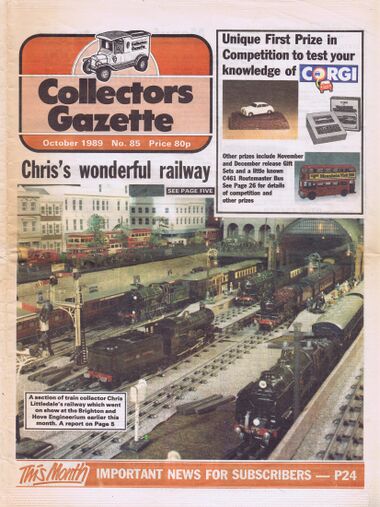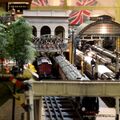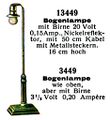Category:1930s Model Railway Layout: Difference between revisions
(→History: 1991) |
(+more obvious Chris mention) |
||
| (4 intermediate revisions by the same user not shown) | |||
| Line 1: | Line 1: | ||
{{Display|Arch=3|DisplayArea=01|Pic=Area_01.jpg}} | {{Display|Arch=3|DisplayArea=01|Pic=Area_01.jpg}} | ||
{{Box|Loco_and_passenger,_Area_01.jpg|Passenger waiting for a train| | {{Box|Collectors_Gazette,_October_1989.jpg|1989: The layout featured on the cover of [[Collectors Gazette]], at the [[British Engineerium]]|380}} | ||
{{Box|Traction_engine,_postwar_(Triang_Minic_44M_54M).jpg|Traction engine, near the layout's bowling green|380}} | |||
{{Box|Loco_and_passenger,_Area_01.jpg|Passenger waiting for a train|380}} | |||
The Museum's '''gauge 0 model railway layout''' forms the main centrepiece of [[the Museum]], and its three-rail track is packed with around fifty [[gauge 0]] locomotives and trains. Apart from the central buildings in the layout (which were designed to approximate Brighton architecture), the trackside buildings and accessories are authentic period-piece accessories. | The Museum's '''gauge 0 model railway layout''' forms the main centrepiece of [[the Museum]], and its three-rail track is packed with around fifty [[gauge 0]] locomotives and trains. Apart from the central buildings in the layout (which were designed to approximate Brighton architecture), the trackside buildings and accessories are authentic period-piece accessories. | ||
The layout was created by museum Founder [[Chris Littledale]], and is designed to produce an immersive impression of city and town life in Britain in the 1930s. | |||
{{BigPic|Early_artwork_for_1930s_gauge_0_model_railway_layout_(Chris_Littledale,_1985).jpg|1985: Early artwork produced by Chris Littledale for the layout}} | |||
{{BigPic|BTMM_zero-gauge_002.jpg|Layout, "goods yard" side}} | |||
==Features== | |||
The [[Grand Station (Marklin)|Märklin "Grand Station"]] (modelled on Liepzig Station) is a particularly grand piece of tinplate art, and the large [[Grand Bridge (Marklin)|Märklin bridge]] with illuminated beacons and side walkways is the only example of the piece known to exist. | The [[Grand Station (Marklin)|Märklin "Grand Station"]] (modelled on Liepzig Station) is a particularly grand piece of tinplate art, and the large [[Grand Bridge (Marklin)|Märklin bridge]] with illuminated beacons and side walkways is the only example of the piece known to exist. | ||
The layout's items range from 1910 to 1960. Most of the locomotives, rolling stock and accessories were manufactured by [[Hornby]] (Meccano), [[Bassett-Lowke]], [[Bing]], [[Märklin]], [[Georges Carette]], [[Elettren]], [[Milbro|Mills Bros.]], [[Bond's]], [[Leeds|Leeds Model Co.]], [[Exley]], [[Marescot]], [[Jouet]] and [[Charles Rossignol]]. The tin plate road vehicles are [[Minic Vehicles|Triang Minic]]s from the 1930s and 1950s. This collection will eventually pass to the Littledale / Brough Trust, the intention being for the collection to remain intact for the benefit of future generations. | The layout's items range from 1910 to 1960. Most of the locomotives, rolling stock and accessories were manufactured by [[Hornby]] (Meccano), [[Bassett-Lowke]], [[Bing]], [[Märklin]], [[Georges Carette]], [[Elettren]], [[Milbro|Mills Bros.]], [[Bond's]], [[Leeds|Leeds Model Co.]], [[Exley]], [[Marescot]], [[Jouet]] and [[Charles Rossignol]]. The tin plate road vehicles are clockwork [[Minic Vehicles|Triang Minic]]s from the 1930s and 1950s. | ||
This collection will eventually pass to the Littledale / Brough Trust, the intention being for the collection to remain intact for the benefit of future generations. | |||
==Limited interactivity on normal opening days== | ==Limited interactivity on normal opening days== | ||
Most of the central layout is designed for manual operation, and is primarily a static display. Visitors can also normally make one train perform a single circuit of the layout by pressing a | Most of the central layout is designed for manual operation, and is primarily a static display. Visitors can also normally make one train perform a single circuit of the layout by pressing a button alongside the display ... however, this ''is'' real vintage 1930s track, and it can sometimes be a little temperamental – and sometimes the pushbutton section is offline while we wait for a service person to examine the track and find a bad electrical connection. | ||
Due to the irreplacability of some of the items on the layout, very few people are allowed access to the layout, so getting it fixed when a problem arises can take a while. | Due to the irreplacability of some of the items on the layout, very few people are allowed access to the layout, so getting it fixed when a problem arises can take a while. | ||
| Line 17: | Line 26: | ||
==History== | ==History== | ||
Before the museum's creation in [[1991]] the layout would be displayed at events at the [[British Engineerium]] in Hove. | |||
Before the museum | |||
{{links}} | |||
* [https://www.youtube.com/watch?v=aZaJyI022Ek Coronation Scot Train Running Day at Brighton Toy and Model Museum (youtube.com)] – ''video'' | |||
[[Category:Arch Three]] | [[Category:Arch Three]] | ||
[[Category:Gauge 0]] | [[Category:Gauge 0]] | ||
[[Category:Model railway layouts]] | [[Category:Model railway layouts]] | ||
{{CL}} | |||
Latest revision as of 11:30, 28 August 2021
| Display Area |
|---|
 |
| 01 - 1930s Model Railway Layout Arch Three |
| –– 01 02 03 04 05 06 07 08 09
10 11 12 13 14 15 16 17 18 19 20 21 22 23 24 25 26 27 28 29 30 31 32 33 34 35 36 37 38 39 40 41 42 43 44 45 46 47 48 49 50 51 52 53 54 55 –– 57 58 –– –– 61 62 63 64 65 66 67 –– –– –– 71 72 73 74 –– 76 77 78 79 80 81 82 83 84 85 86 –– –– –– |
1989: The layout featured on the cover of Collectors Gazette, at the British Engineerium [image info]
Traction engine, near the layout's bowling green [image info]
Passenger waiting for a train [image info]
The Museum's gauge 0 model railway layout forms the main centrepiece of the Museum, and its three-rail track is packed with around fifty gauge 0 locomotives and trains. Apart from the central buildings in the layout (which were designed to approximate Brighton architecture), the trackside buildings and accessories are authentic period-piece accessories.
The layout was created by museum Founder Chris Littledale, and is designed to produce an immersive impression of city and town life in Britain in the 1930s.
Features
The Märklin "Grand Station" (modelled on Liepzig Station) is a particularly grand piece of tinplate art, and the large Märklin bridge with illuminated beacons and side walkways is the only example of the piece known to exist.
The layout's items range from 1910 to 1960. Most of the locomotives, rolling stock and accessories were manufactured by Hornby (Meccano), Bassett-Lowke, Bing, Märklin, Georges Carette, Elettren, Mills Bros., Bond's, Leeds Model Co., Exley, Marescot, Jouet and Charles Rossignol. The tin plate road vehicles are clockwork Triang Minics from the 1930s and 1950s.
This collection will eventually pass to the Littledale / Brough Trust, the intention being for the collection to remain intact for the benefit of future generations.
Limited interactivity on normal opening days
Most of the central layout is designed for manual operation, and is primarily a static display. Visitors can also normally make one train perform a single circuit of the layout by pressing a button alongside the display ... however, this is real vintage 1930s track, and it can sometimes be a little temperamental – and sometimes the pushbutton section is offline while we wait for a service person to examine the track and find a bad electrical connection.
Due to the irreplacability of some of the items on the layout, very few people are allowed access to the layout, so getting it fixed when a problem arises can take a while.
Train Running Days/Train Running Evenings
Anyone with a particular interest in seeing the layout running in its full glory is recommended to visit during one of our themed Train Running Days. As a rule we run two of these each year (one in Spring and one in Autumn/Winter), and on these occasions we run multiple vintage locomotives and trains on multiple sections of track, with lots of people on hand to jump in and fix things if there's a problem.
History
Before the museum's creation in 1991 the layout would be displayed at events at the British Engineerium in Hove.
External links
Subcategories
This category has the following 7 subcategories, out of 7 total.
1
- 1930s Layout, bottom (4 P, 3 F)
- 1930s Layout, central section, front (30 P, 23 F)
- 1930s Layout, central section, rear (21 P, 7 F)
- 1930s Layout, top (20 P, 14 F)
- 1930s Layout, undershelves (2 P)
Pages in category ‘1930s Model Railway Layout’
The following 68 pages are in this category, out of 68 total.
C
- Caledonian Railway locomotive 142 (Bassett-Lowke gauge 0)
- CIWL coaches (Elettren)
- CIWL coaches (Marklin)
- Coronation locomotive 6220 paperweight
- Corridor First-Third Carriage, SR 890 (Bond's of Euston Road)
- Corridor First-Third Class Carriage, SR 7890 (Windsor Model Company)
- Corridor Third - Luggage Car, SR 890 (Windsor Model Company)
- Corridor Third - Luggage Car, SR 901 (Windsor Model Company)
F
G
- Gas Cylinder Wagon, green, SR (Hornby)
- George the Fifth locomotive 2663 (Bing / Bassett Lowke)
- George the Fifth locomotive LMS 5320 (Bing / Bassett Lowke)
- Great Western 0-6-0 tank locomotive 2783 (Beeson for Bassett-Lowke)
- Grosvenor Pullman Car (Milbro, upgraded)
- GWR Express Cartage Service Van B4157 (Triang Minic 79M)
L
- LBSCR tank locomotive 11 (Bing for Bassett-Lowke)
- Loading Gauge, ~1934 (Hornby Series)
- Locomotive No2 Special, LMS 1185 (Hornby Series)
- Locomotive, green, 4-6-2 (Märklin HR 66-12920)
- Lord Nelson locomotive SR 850 (Milbro)
- Luggage Guard Van, SR 586 (Windsor Model Company)
- Luggage Guard Van, SR 877 (Windsor Model Company)
M
P
- Postal Carriage, LNWR 1339, gauge 0 (Carette for Bassett-Lowke)
- Pullman No2 Special Coach (Composite), Alberta (Hornby Series)
- Pullman No2 Special Coach (Composite), Arcadia (Hornby Series)
- Pullman No2 Special Coach (Composite), Verona (Hornby Series)
- Pullman No2 Special Coach, Grosvenor (Hornby Series)
- Pullman No2 Special Coach, Iolanthe (Hornby Series)
- Pullman No2 Special Coach, Loraine (Hornby Series)
- Pullman No2 Special Coach, Zenobia (Hornby Series)
S
- SECR Steam Rail Motor Coach No1, gauge 0 (Georges Carette)
- Signal Box (Georges Carette)
- Signal Box (Superquick A6X)
- Signal, double-arm, No2E (Hornby Series)
- Southern No.2 Corridor Coaches (Hornby Series)
- Southern No.2 Corridor Composite Coaches (Hornby Series)
- Sports Saloon (Tri-ang Minic 4M)
- Station electric lamp, repaint, green (Märklin 3448)
- Station Electric Lamps (Märklin 3448)
- Stirling Single locomotive, gauge 0 (Denis Hefford)
- Street Lamp (Märklin 3449)
- Street Lamp (Märklin 3550)
T
Media in category ‘1930s Model Railway Layout’
The following 60 files are in this category, out of 60 total.
- 0-gauge.jpg 1,632 × 1,224; 681 KB
- 1930s gauge 0 model railway layout, view 05.jpg 2,160 × 1,620; 1.48 MB
- 1930s model railway layout, bridge view.jpg 1,800 × 1,200; 1.4 MB
- Area 01.JPG 1,024 × 768; 474 KB
- Area 01.jpg 1,200 × 1,200; 836 KB
- Area 01b.JPG 1,024 × 768; 392 KB
- Area 01c.JPG 1,024 × 768; 463 KB
- Area 01d.jpg 1,024 × 768; 497 KB
- Arsenal 2848 locomotive (Bassett-Lowke).jpg 1,200 × 900; 613 KB
- Bassett-Lowke, King George V 6000, gauge 0 (BL-MR 1937-11).jpg 1,541 × 2,130; 510 KB
- Bogenlampe - Street Lamp, Märklin 3499 (MarklinCat 1931).jpg 936 × 1,021; 282 KB
- Bogenlampe - Street Lamp, Märklin 3550 (MarklinCat 1931).jpg 964 × 1,393; 320 KB
- Bonzone Dockland Tank Locomotive No2 (Bonds 1932-2ed).jpg 1,520 × 2,000; 1.12 MB
- Brighton 915 Schools-Class loco (ACE Trains).jpg 800 × 600; 285 KB
- Britains Gardening painted lead flowerbed (gauge 0 layout).jpg 2,500 × 973; 1.29 MB
- BTMM zero-gauge 002.jpg 627 × 326; 62 KB
- Carter Paterson and Pickfords Removals Lorry, clockwork (Triang Minic).jpg 1,024 × 768; 453 KB
- CIWL railway carriage, gauge 0 (Elettren).jpg 1,200 × 676; 468 KB
- CIWL railway carriage, gauge 0 (Marklin).jpg 1,200 × 800; 558 KB
- Collectors Gazette, October 1989.jpg 1,649 × 2,200; 953 KB
- Coronation loco Area 01.jpg 640 × 480; 187 KB
- Coronation Scot nine-car train (Bassett-Lowke).jpg 1,200 × 562; 468 KB
- Diesel locomotive LMS 10001 (Bond's of Euston Road).jpg 800 × 600; 304 KB
- Duchess of Gloucester 6225 Bassett-Lowke.jpg 640 × 480; 204 KB
- Duchess of Gloucester locomotive, LMS 6225 (Bassett-Lowke).jpg 2,200 × 1,469; 2.71 MB
- Early artwork for 1930s gauge 0 model railway layout (Chris Littledale, 1985).jpg 3,000 × 1,683; 2.15 MB
- Eton 900 locomotive detail, Hornby.jpg 800 × 600; 381 KB
- Fence, Märklin 2667 (MarklinCat 1936).jpg 1,414 × 747; 367 KB
- Flower Bed with Grass Border, Britains Garden 001 (BMG 1931).jpg 1,024 × 614; 269 KB
- Flower Bed with Grass Border, Britains Garden 006 (BMG 1931).jpg 1,024 × 996; 398 KB
- Folkestone Flyer No2 Special train Set, SR (HBoT 1938).jpg 2,599 × 1,641; 456 KB
- Gas cylinder wagon, SR, green (Hornby).jpg 800 × 600; 239 KB
- George the Fifth loco 5320, cab side (Bing for Bassett-Lowke).jpg 1,024 × 768; 565 KB
- George the Fifth loco 5320, engine (Bing for Bassett-Lowke).jpg 1,024 × 640; 525 KB
- Hornby E220 Special Locomotive, LMS 1185 (HBoT 1934).jpg 1,961 × 1,477; 402 KB
- Hornby E420 Eton Locomotive (1939- catalogue).jpg 2,269 × 999; 278 KB
- Hornby No2 Corridor Coach, Corridor Composite Coach, SR, green (HBoT 1938).jpg 1,334 × 863; 121 KB
- Hornby No2 Special locomotive, LMS 1185 (HBoT 1938).jpg 1,586 × 1,094; 172 KB
- Hornby No4 locomotive SR 900 Eton (HBoT 1938).jpg 2,413 × 1,123; 356 KB
- Hornby Princess Elizabeth 6201 locomotive detail.jpg 1,024 × 768; 384 KB
- J.T. Lowke and Sons boiler (Bassett-Lowke).jpg 1,024 × 768; 530 KB
- King George V locomotive 6000 (Marklin).jpg 1,200 × 675; 504 KB
- LNER locomotive 2838 Melton Hall (Bassett-Lowke).jpg 2,500 × 1,667; 1.98 MB
- Loco and passenger, Area 01.jpg 640 × 480; 175 KB
- Locomotive LNER 4472 Flying Scotsman, gauge 0 (Bassett-Lowke).jpg 1,024 × 768; 414 KB
- Locomotive SR 1759, Hornby No2 Special (1930s layout).jpg 1,600 × 1,200; 1.35 MB
- Locomotive, 4-6-2, Märklin HR 66-12920, HR 66-12921 (MarklinCat 1932).jpg 3,000 × 1,258; 1.67 MB
- MarklinBridge BTMM.jpg 810 × 686; 176 KB
- Milbro Lord Nelson loco, Southern 850.jpg 1,200 × 676; 511 KB
- Nord locomotive 3-1251 (Fournereau).jpg 1,600 × 899; 873 KB
- Pullman Car Brenda, pic2 (Bond's of Euston Road).jpg 1,200 × 675; 501 KB
- Pullman No.2 Special Coach, Hornby Series (HBoT 1931).jpg 971 × 569; 153 KB
- Pullman No2 Special Coaches, Verona and Loraine (HBoT 1938).jpg 1,591 × 767; 168 KB
- Signal Box, Superquick A6 (SQ 2000-01).jpg 1,298 × 902; 630 KB
- Station Arc Lamp, Märklin 3548 (MarklinCRH ~1925).jpg 659 × 916; 150 KB
- The Hand of God.jpg 640 × 480; 163 KB
- Triang Minic clockwork vehicles, on the gauge 0 model railway layout 01 (2018).jpg 3,000 × 2,000; 2.46 MB
- Triang Minic clockwork vehicles, on the gauge 0 model railway layout 02 (2018).jpg 3,000 × 1,683; 2.51 MB
- WH Hull goods wagon (Bing for Bassett-Lowke).jpg 1,024 × 577; 373 KB
- Wulf Never, House of Marklin.jpg 1,200 × 800; 570 KB



































































